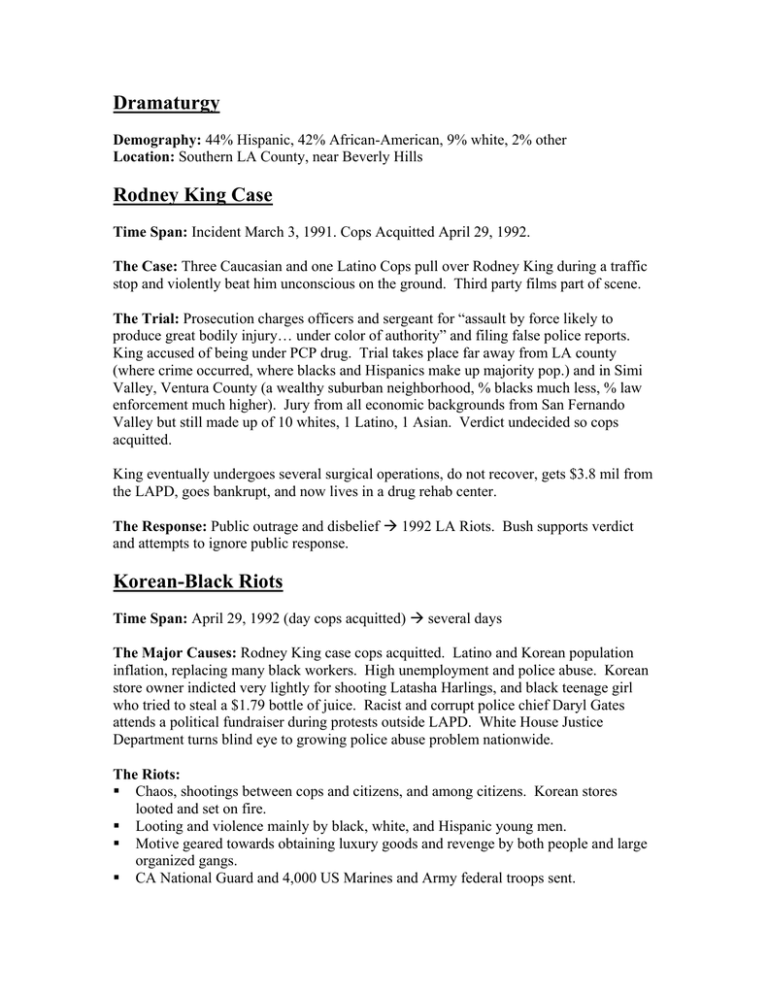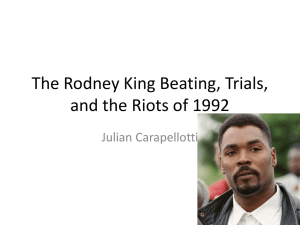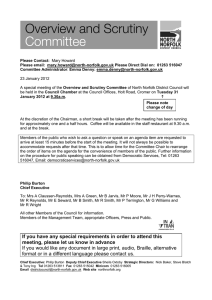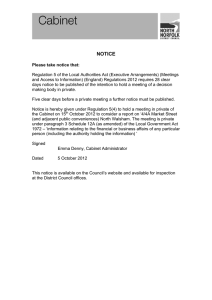Dramaturgy Rodney King Case
advertisement

Dramaturgy Demography: 44% Hispanic, 42% African-American, 9% white, 2% other Location: Southern LA County, near Beverly Hills Rodney King Case Time Span: Incident March 3, 1991. Cops Acquitted April 29, 1992. The Case: Three Caucasian and one Latino Cops pull over Rodney King during a traffic stop and violently beat him unconscious on the ground. Third party films part of scene. The Trial: Prosecution charges officers and sergeant for “assault by force likely to produce great bodily injury… under color of authority” and filing false police reports. King accused of being under PCP drug. Trial takes place far away from LA county (where crime occurred, where blacks and Hispanics make up majority pop.) and in Simi Valley, Ventura County (a wealthy suburban neighborhood, % blacks much less, % law enforcement much higher). Jury from all economic backgrounds from San Fernando Valley but still made up of 10 whites, 1 Latino, 1 Asian. Verdict undecided so cops acquitted. King eventually undergoes several surgical operations, do not recover, gets $3.8 mil from the LAPD, goes bankrupt, and now lives in a drug rehab center. The Response: Public outrage and disbelief Æ 1992 LA Riots. Bush supports verdict and attempts to ignore public response. Korean-Black Riots Time Span: April 29, 1992 (day cops acquitted) Æ several days The Major Causes: Rodney King case cops acquitted. Latino and Korean population inflation, replacing many black workers. High unemployment and police abuse. Korean store owner indicted very lightly for shooting Latasha Harlings, and black teenage girl who tried to steal a $1.79 bottle of juice. Racist and corrupt police chief Daryl Gates attends a political fundraiser during protests outside LAPD. White House Justice Department turns blind eye to growing police abuse problem nationwide. The Riots: Chaos, shootings between cops and citizens, and among citizens. Korean stores looted and set on fire. Looting and violence mainly by black, white, and Hispanic young men. Motive geared towards obtaining luxury goods and revenge by both people and large organized gangs. CA National Guard and 4,000 US Marines and Army federal troops sent. Two largest LA street gangs (Crips and Bloods) form truce and demand political change in LA law enforcement. King appears on TV asking for peace and reconciliation. The Damage: 50-60 lives, 2,000 injuries, 3,600 fires, 1,100 buildings destroyed, 10,000 arrested (ethnicity of those arrested consistent with demography). $800 mil to $1 bil in property damage. Smaller riots included in San Francisco, NY, Seattle, Chicago, Toronto, Wisconsin. Reginald Denny Case Time Span: Beating April 29, 1992. Last charge Dec 7, 1993. The Case: Truck driver Denny gets pulled out of truck and beaten unconscious and shot at by several minority citizens and gang members. News helicopter reporter Bob Tur videotapes event. The Trial: Jury of 5 whites, 3 blacks, 3 Latinos, 1 Asian. Defendants initially acquitted except for a felony mayhem and misdemeanor charge. Later one of the defendants repunished with 10 yrs in jail but released early. The Response: Public celebration. White people in affluent areas such as Beverly Hills furious and racial gap tensions widen. Denny now in Arizona as boat motor mechanic but paid lots of $$ to speak in public. Sources: 1992 Los Angeles Riots. Wikipedia: The Free Encyclopedia. Online Source. Apr 17, 2006. <http://en.wikipedia.org/wiki/1992_Los_Angeles_riots> Reginald Oliver Denny. Wikipedia: The Free Encyclopedia. Online Source. Apr 17, 2006. <http://en.wikipedia.org/wiki/Reginald_Oliver_Denny> Rodney King. Wikipedia: The Free Encyclopedia. Online Source. Apr 17, 2006. <http://en.wikipedia.org/wiki/Rodney_King> Smith, Anna Deveare. Twilight—Los Angeles 1992. Anchor Books: New York. 1994. Racial Tensions and Ironies: 1) Aside from the Reginald Denny beating and the Latasha Harling shooting, most of the racial suppression originated mainly from the white policeman brutality. Yet the resulting violence and revenge by black citizens were geared physically towards Koreans and other minorities, whereas the non-physical revenge were geared towards whites (see Your Heads in Shame p.70-73). Which of these types of revenge do you think are most damaging? Why do the public respond differently towards different ethnic groups? Does demography and economic distribution of people play a role? --------------------------------------------------------------------------------2) Both the prosecutions for the Rodney King and Reginald Oliver Denny trial relied heavily on videos of the scene shot by a third party. Furthermore, the jury for the Rodney King trial comprised of ten white, one Asian, and one Latino jurors, whereas that for the Reginald Denny trial comprised of five white, three black, three Hispanic, and one Asian jurors. Consequently, the defendants in both trials were initially either acquitted or sentenced to very light punishments. How do you compare the racial ironies that stem from these two trials? (See Magin p.75-6) --------------------------------------------------------------------------------3) Interpret the attitudes of the riots and irony in the speeches from the different characters below: Law Enforcements: Former LA Police commission president (p.14-15) LAPD Use-of-force expert for defense (p.64) Affluent and/or Caucasions: USC Sorority Girl (p.158) Judith Tur (p.96-8) (third person’s description of reporter) Katie Miller (p.132) Elaine Young at the Beverly Hills Hotel (p.155) Black Residents: Ex-gang member Big Al (p.100-2) Julio Menjivar (p.126-8) (on view towards Latinos and Asians) Free the LA 4+ Defense (p.175) Uncalled witness Josie Morales (p.68-9) Participants: Korean Store owner (p.89) Reginald Denny (p.104-7) LA Mayor Tom Bradley (p.85) and Congresswoman Maxine Waters (p.166-7) --------------------------------------------------------------------------------- 4) How would you have read the testimonials differently if Smith hadn’t included the character and setting descriptions before each speech? --------------------------------------------------------------------------------5) Do you think this Law Enforcement brutality awareness eventually caused people to be more racially tolerant, or did this just increase racial tensions. Did we end up with both occurring? (See A Jungian Collective Unconscious p.212 and testimonials of Caucasian characters)


